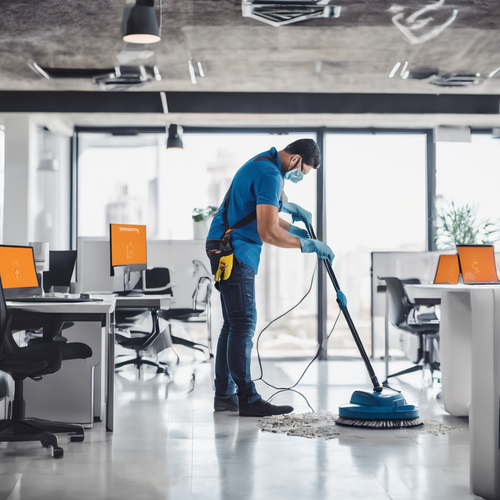How IoT is Revolutionizing Professional Cleaning Services
Imagine a world where your vacuum cleaner communicates with your refrigerator to decide the optimal time for a cleaning session, where schedules are adjusted at the sound of your voice, and where dirt doesn’t stand a chance against a barrage of real-time data. It seems like science fiction, but in the realm of professional cleaning, the Internet of Things (IoT) is making this futuristic vision a reality. From robotic vacuums to smart sensors, IoT is transforming how cleaning services operate, shifting them from the mundane to the extraordinary. ✨
The Smarter Way to Clean
Gone are the days when a mop and bucket were the pinnacle of cleaning technology. The shift to IoT in the cleaning sector brings a breath of fresh air, much like a spring breeze displacing stovepipe smoke. Through connected devices that gather and analyze data, cleaning companies are no longer relying solely on traditional methods. Instead, they’re engaging in a dance of technology and efficiency, crafting smarter cleaning solutions.
Consider this: a survey from McKinsey & Company found that companies using IoT solutions report an increase in productivity of up to 30%. This isn’t serendipity; it’s a calculated evolution. Devices equipped with sensors collect data on foot traffic in buildings, allowing cleaning schedules to be optimized based on actual need rather than a fixed routine, thus striking a perfect antithesis to yesterday’s rigid timelines.
Data-Driven Cleaning: The New Intelligence
In a world flush with data, why would cleaning be any different? IoT allows professionals to harness vast amounts of data to create a more tailored cleaning experience. Imagine sensors in a shopping mall that track foot traffic, enabling cleaning crews to target high-traffic areas at ideal times. It’s akin to conducting a symphony where every instrument is harmonized for maximum impact. The result? Cleaner environments without the disruption of cleaning in off-peak hours.
Plus, these smart devices can notify cleaning services when they’re running low on supplies, preventing a dreaded “running out of toilet paper” moment in that vital public restroom. As they say, a clean environment is a happy environment – a principle that does not go unnoticed in an age driven by customer satisfaction.
The Rise of Robotics: Automation Meets Realities
At the heart of this transformation lies the surge of robotics within the cleaning profession. Robotic vacuums, once confined to a niche market of homeowners, are rapidly infiltrating commercial venues. Picture your local hospital, where robots glide silently through halls, cleaning as they go—both efficient and low on drama. Much like a stealthy ninja warrior, they eliminate dirt and germs, allowing human operators to focus on complex cleaning tasks, a striking contrast to the past where human labor was the only option.
Yet, this automation isn’t devoid of human touch. The reality is, cleaning bots work best when they are part of a broader team that includes human staff who can perform specialized tasks that require a personal touch. It’s a partnership where each entity plays to its strengths—the brainy IoT devices handle data and routine, while humans tackle the unpredictable nature of their environments.
Challenges Ahead: A Double-Edged Sword
However, like all powerful transformations, IoT comes with its caveats. As cleaning companies become increasingly reliant on technology, they also become more vulnerable to cyber risks. Data breaches, hacking incidents, and system failures can wreak havoc not only on operations but also on customer trust. It’s akin to a double-edged sword—while it cuts through inefficiencies, it also requires a cautious grip to avoid injury.
“Technology is best when it brings people together. It is a challenge but also an opportunity,” states tech analyst Julie Schmidt, echoing the sentiment that IoT should not replace human connections, but enhance them.
The Future Clean: A Vision of Sustainability
Beyond mere efficiency lies the vision of sustainability. IoT enables cleaning services to monitor resource usage in real-time, minimizing waste. Sensors can optimize water consumption for cleaning, ensuring that every drop counts. This is particularly poignant in today’s climate-conscious society, where the cleaning industry faces scrutiny for its environmental impact.
Moreover, the synergy created between IoT and eco-friendly products reassures clients of sustainable practices. Imagine specifying green cleaning agents loaded with sensors that guarantee their efficacy, enhancing the cleaning while embracing the planet. It’s like singing in harmony with Mother Nature rather than serenading her with the discordant tunes of synthetic chemicals. 🌍
In Practice: Real-Life Applications of IoT
Let’s peek behind the curtain and see how some companies are executing this shift:
- Smart Sensors: Facilities management companies like Johnson Controls are employing IoT sensors to enhance sanitation in high-touch areas, ensuring schools and offices maintain stringent cleanliness standards.
- Automated Scheduling: Firms like Germfree utilize data analytics to predict cleaning needs, resulting in more efficient labor allocation without common roadblocks like overstaffing during slow hours.
- Connected Cleaning Tools: Companies are integrating cleaning machines with real-time monitoring capabilities, allowing team leaders to quickly address issues and adapt strategies as circumstances demand.
As the industry embraces technology, trust becomes paramount. Clients need to know their information, operations, and the very products used to clean their spaces are safeguarded with extreme diligence. After all, a dirty floor may spark grievances, but a suspicious breach could provoke wild tales and dramatic fallout.
Wrapping It Up: A Clean Future Awaits
The cleaning services of tomorrow are not only cleaner; they are smarter, more data-driven, and ultimately more reflective of a connected society. The amalgamation of IoT within this sector symbolically dances toward a future where the traditional notions of cleaning are reshaped—around efficiency, sustainability, and human connection. So, next time you see a robot scuttling across the floor, don’t just think about crumbs being picked up. Think about how IoT is changing the very way we interact with our environments, clean them, and ultimately, live within them. After all, in a world where cleanliness is next to godliness, IoT is the divine intervention we’ve all been waiting for. ✨
